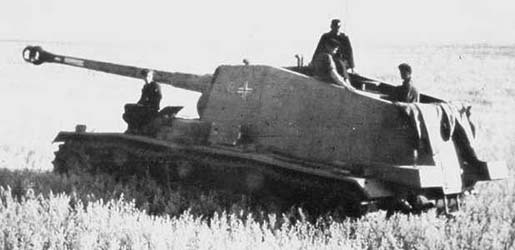/Vehicles/Axis/Germany/04-Panzerjaegers/Sturer-Emil/File/Sturer-Emil.htm | Last Up-date:
12.8 cm Selbstfahrlafette L/61 "Sturer Emil" (Tank Destroyer)
Quand le projet VK3001(H) fut abandonné au profit du développement du VK3601(H) on décida d'utiliser les châssis des prototypes pour concevoir un affût mobile pour le canon antichar de 128 mm. En mars de 1941, deux VK3001(H) furent fournis pour concevoir ce canon automoteur. La firme Rheinmetall-Borsig fourni ldeux canons de 128mm PaK 40 L/61 (développé en 1939, à partir du canon anti-aérien de 128mm). Pour accueillir ce canon le châssis fut allongé ce qui nécessita l'addition d'un galet supplémentaire. Le compartiment de combat protégé par une superstructure ouverte était monté à l'arrière au dessus du compartiment moteur. Le canon de 128 mm avait un champ de tir horizontal limité à 7° de chaque côté. L'espace à l'intérieur ne permettait le stockage que de seulement 15 à 18 projectiles de 128 mm. Pour sa défense rapproché, le nouveau panzerjäger disposait d'une mitrailleuse MG34 de 7.92 mm montée sur rotule sur la plaque frontale du haut de la caisse. Le blindage frontale était de 50 mm et pour les côtés de 15 à 30 mm.
When the project VK3001(H) was abandoned to the profit of the development of VK3601(H) one decided to use the chassis of the prototypes to design a mobile mounting for the anti-tank gun of 128 mm. In March of 1941, two VK3001(H) were provided to design this self-propelled gun. The Rheinmetall-Borsig firm provided two guns of 128mm PaK 40 L/61 (developed in 1939, starting from the anti-aircraft gun of 128mm). To accomodate this gun, the chassis was lengthened what required the addition of an additional road wheel. The compartment of combat protected by an open superstructure was assembled to the back on the top of the engine compartment. The gun of 128 mm had a horizontal field of fire limited to 7° on each side. Space inside allowed only storage of 15 to 18 projectiles of 128 mm. For its local defense, the new panzerjäger had a machine-gun MG34 of 7.92 mm mounted on ball on the frontal plate of the upper hull. The frontal shielding was of 50 mm and for the sides from 15 to 30 mm.
 |
12.8 cm Selbstfahrlafette L/61
(Panzerselbstfahrlafette V) "Sturer Emil"
|
src: site "Achtung
Panzer!"
|
Entre août 1941 et mars 1942, Henschel produisit deux prototypes, qui tout deux furent envoyés en Russie vers la mi 1942, pour être éxaminé sur le terrain. L'un des deux fut versés dans le 521e schwere Panzerjaeger Abteilung et le deuxième dans la 2e Pz-Division. Ce dernier fut détruit au combat alors que le premier fut capturé par les Russes en janvier 1943 à Stalingrad. Le 12.8 cm Selbstfahrlafette L/61 (Panzerselbstfahrlafette V) "Sturer Emil" (Emil le têtu) était une arme antichar très performante mais qui ne fut jamais acceptée pour la production, le développement du Tiger étant largement prioritaire.
Between August 1941 and March 1942, Henschel produced two prototypes, which all two were sent in Russia in mid 1942, to be examined on the front. One of both was versed in the 521st schwere Panzerjaeger Abteilung and the second in the 2nd Pz-Division. This last was destroyed in the combat whereas the first was captured by the Russians in January 1943 in Stalingrad. 12.8 cm Selbstfahrlafette L/61 (Panzerselbstfahrlafette V)"Sturer Emil" (Stubborn Emil) was a very powerful anti-tank weapon but which was never accepted for the production, the development of Tiger having largely priority.
 |
12.8 cm Selbstfahrlafette L/61
(Panzerselbstfahrlafette V) "Sturer Emil"
|
src: site "Achtung
Panzer!"
|
128
mm K 40 L/61 Penetration of a shielding plate (mm) under a plunging angle of 30° |
|||||||
Ammo |
Weight |
Velocity |
100
m |
500 m |
1000
m |
1500 m |
2000
m |
| PzGr | 26.4 kg |
880 m/s |
201 |
176 |
150 |
132 |
120 |
Data |
Drawings |
Sources:
- Connaissance de l'Histoire (Hachette) - N°17 - " Les chars de combat allemands 39-45"
- Les Blindés de la Seconde Guerre Mondiale (Atlas)
- Site "Achtung Panzer" - http://www.achtungpanzer.com
- Site "WWII Vehicles" - http://www.wwiivehicles.com/germany/tank-hunters/selbstfahrlafette-v.asp